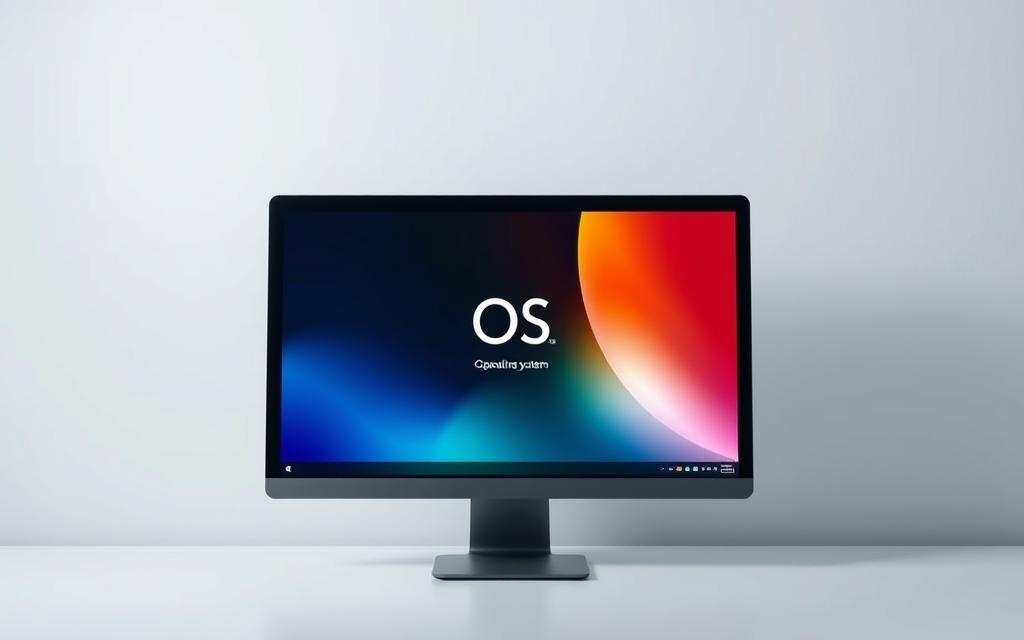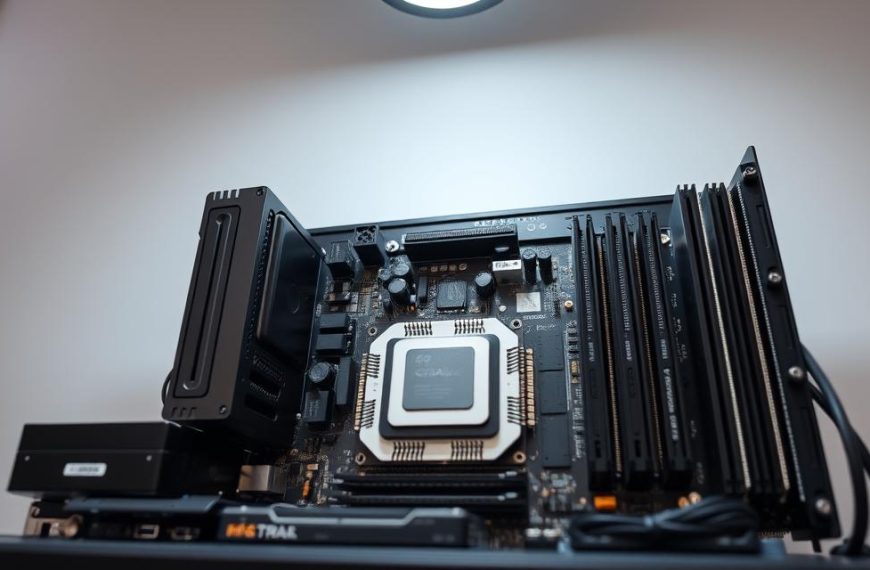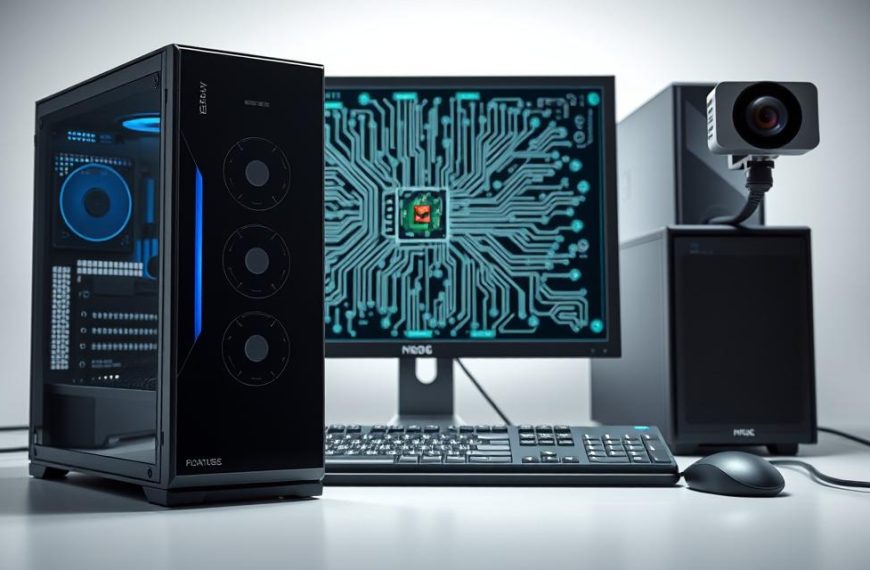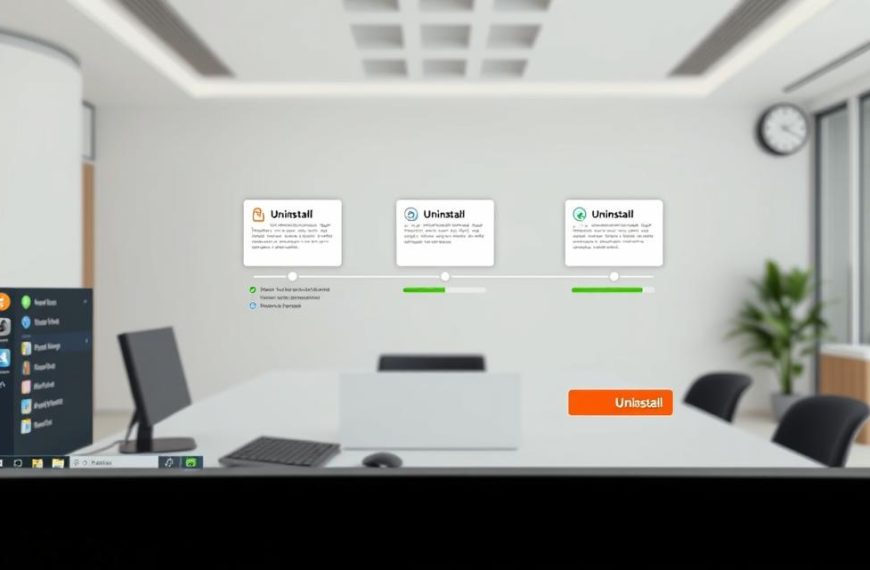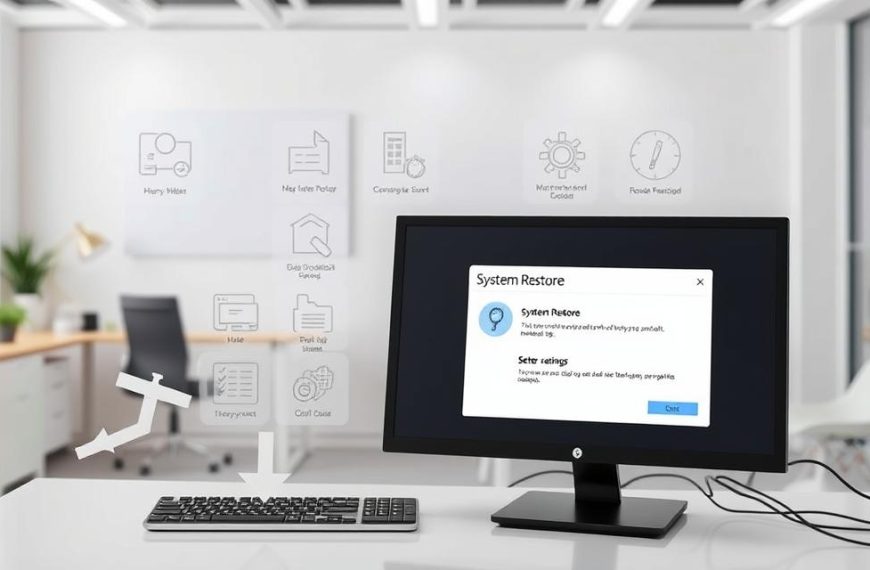Knowing your computer’s operating system is key for easy use. It decides which programmes you can run and how your machine works.
When you install new software or need tech help, knowing your operating system details is vital. It saves time and avoids problems. IT experts often ask for this info when fixing issues.
Knowing your system is also important for security updates. Different versions get updates at different times. This keeps your device safe from threats.
This guide will teach you how to check OS version info. We’ll look at easy settings and more technical tools for all levels.
Knowing your system’s specs helps you make smart choices about software. It also keeps your computer running well.
Understanding the Importance of Knowing Your OS
Your operating system is the base of what your computer does. Knowing which version you’re using is more than just a fact. It affects how well your device works, its safety, and if it can use new software.
When you install new software, it often needs a certain OS version. Using an old version might stop you from using the latest apps or features. Keeping your OS up to date lets you use your favourite programmes fully.
Security is another big reason to know your OS. New threats come out all the time, and updates fix these issues. If your OS is not updated, your device could get hacked or infected with malware.
Knowing your OS also helps with hardware. Drivers and other hardware need the right OS version to work right. Having the right system information stops hardware problems.
Lastly, knowing your OS is key when you need help. IT teams, like Drexel IT, say they always ask for the OS version first. This helps them fix problems faster.
“We always ask for the operating system version first—it’s the starting point for effective troubleshooting.”
When you call for help, they’ll ask for your OS version right away. Giving them the right system information makes fixing problems quicker.
Knowing your OS lets you:
- Install software and hardware that works
- Keep your system safe from threats
- Talk to support teams easily
- Plan when to update your system
This knowledge makes you a more active computer user. You’ll spend less time on IT troubleshooting and avoid problems that slow you down.
Whether you use your computer for fun or work, knowing your OS makes your experience better. The next parts will show you how to find this important info on your device.
What Operating System Do I Have on My Computer: Windows Methods
Windows users have several ways to find out their operating system details. Each method gives different levels of information. You can choose based on how much detail you need.
Using Settings App to Identify Windows Version
The Settings app is the easiest way to check your Windows version. It’s simple to use and gives you the basic system details you need.
To start, go to System > About in the Settings app. Here, you’ll see two main sections. The first shows your device’s hardware, like the processor and RAM. The second tells you about your Windows version.
For quick access, right-click the Start button and choose Settings. This will take you straight to the Windows specifications.
System Information Utility for Detailed Analysis
If you need more detailed system information, the System Information utility (msinfo32) is the best choice. It gives a detailed look at your computer’s hardware and software.
To open this utility, press Windows Key + R, type “msinfo32” and press Enter. The window shows your system’s technical details in organised categories. You can see everything from hardware resources to software environment details.
This method is great for troubleshooting or checking software compatibility. You can even save the system details for later use.
Command Line Approaches for Technical Users
For those who are comfortable with terminal interfaces, command line methods are quick and efficient. They give you the information you need without using graphical interfaces.
The systeminfo command gives you a lot of system data when used in Command Prompt or PowerShell. It shows OS version, build number, memory, and network info all in one command.
Another option is the winver command. It opens a dialog box with your Windows version and build info. This is a fast way to check without getting lost in technical details.
| Method | Technical Level | Information Depth | Best For |
|---|---|---|---|
| Settings App | Beginner | Basic system overview | Quick version checks |
| System Information | Intermediate | Comprehensive analysis | Troubleshooting needs |
| Command Line | Advanced | Technical specifications | IT professionals |
Checking Your macOS Version and Build
Apple computer users have a unique way to find their operating system. macOS makes it easy to see your system version. You can get basic or detailed technical info.
Knowing your macOS version is key for software and security updates. Apple updates its system regularly. Each update brings new features and needs.
About This Mac: The Standard Approach
To check your macOS version, start with the Apple menu. Click the Apple icon in the top-left corner. Then, choose “About This Mac” from the menu.
This opens a window with your macOS version and number. You’ll see “macOS Monterey” and a version number like 12.6.1. Below that, you’ll find the build number for technical details.
The window also shows your Mac’s hardware. This includes your Mac model, processor, memory, and graphics. It gives a quick look at your system’s specs.
System Report for Detailed Information
For more detailed system info, click “System Report” in the About This Mac window. This opens the System Information utility. It gives detailed info on your hardware and software.
The System Report organises info into categories. These include:
- Hardware components and their specs
- Installed software and apps
- Network connections and settings
- Storage devices and their sizes
This report is great for tech users and support pros. It helps diagnose issues or check system needs for special software. It offers more than just version checking, showing your system in full detail.
Understanding macOS version numbers is important. Apple’s naming follows a pattern. It includes the major, minor version, and patch level. The build number shows the specific version build.
Identifying Linux Distributions and Versions
Linux systems are tricky to identify because of their many flavours. Unlike Windows or macOS, Linux has lots of different versions. Knowing your Linux distribution identification is key for software, security, and upkeep.
For precise system info, tech users often turn to the terminal. Commands like lsb_release -a give detailed info on your system. This method is the most reliable across various Linux setups.
Terminal Commands for System Identification
Several terminal commands give quick info on your distribution. The lsb_release -a command shows distributor ID, description, and release number. It works well on most major distributions.
cat /etc/os-release reads the system’s identification file. It reveals info like pretty name, version ID, and home URL. The output is consistent across modern Linux distributions.
The hostnamectl command gives system info and hostname details. It’s great for systemd-based distributions, showing OS, kernel, and architecture in an organised way.
Checking Distribution-Specific System Files
Different Linux distributions have unique system files for version info. These files are useful when standard commands don’t work. Knowing how to use these files helps with troubleshooting.
Ubuntu stores release info in /etc/lsb-release and /etc/issue files. These files have human-readable distribution details. Checking them quickly verifies your Ubuntu version.
Fedora uses /etc/fedora-release for version storage. It contains the distribution name and version number. Red Hat Enterprise Linux and CentOS have similar files at /etc/redhat-release.
Debian stores version info in /etc/debian_version. It shows the current release number. This file is simple, but you need extra commands for full details.
| Distribution | Primary Command | System File | Alternative Method |
|---|---|---|---|
| Ubuntu | lsb_release -a | /etc/lsb-release | cat /etc/issue |
| Fedora | hostnamectl | /etc/fedora-release | rpm –query fedora-release |
| Debian | cat /etc/os-release | /etc/debian_version | apt-get update | grep Release |
| CentOS | cat /etc/redhat-release | /etc/centos-release | yum info centos-release |
This table shows the best ways to identify major Linux distributions. Each method offers reliable Linux distribution identification through different technical paths. Knowing these methods ensures you can always find your system’s specs.
Mobile Operating Systems: iOS and Android Checks
In today’s world, knowing your device’s operating system is key. Mobile platforms get updates often. These updates bring new features, security fixes, and better compatibility. To fix app issues or check for updates, knowing your mobile OS version is the first step.
Finding Your iOS Version on Apple Devices
Apple makes it easy to find your iOS version. This is true for all Apple devices like iPhones, iPads, and iPod Touches.
To find your iOS info, follow these steps:
- Open the Settings app from your home screen
- Scroll down and tap on “General”
- Select “About” from the menu options
In the About section, you’ll find lots of info about your device. Your mobile OS version is clearly shown. It includes the major version number and the specific release.
This screen also shows other important details. These include:
- Build number for technical reference
- Device model and capacity
- Serial number and regulatory information
- Carrier settings for cellular devices
This central hub makes it easy for Apple users to find their system specs quickly.
Locating Android Version and Build Information
Android devices are a bit different. Manufacturers add their own touches, so the system looks different. But the core Android system stays the same.
To find your Android version, follow these steps:
- Open the Settings application
- Scroll to the bottom and select “About phone”
- Tap on “Android version” or “Software information”
Some makers might call this section something else. You might see it under “System,” “About device,” or “Software.” Android’s flexibility means your experience can vary.
Once you find the right menu, your mobile OS version will be clear. Tapping on the Android version number a few times can show fun animations.
For detailed tech info, look at the build number next to the version. This helps identify your Android variant. It’s useful for fixing security or compatibility issues.
Manufacturer skins like Samsung’s One UI or Xiaomi’s MIUI might change where you find these options. But “About phone” is always a good starting point for all Android devices.
Checking your mobile OS version often is important. It ensures you get the latest security updates and features for your device.
Practical Scenarios Requiring OS Knowledge
Knowing your operating system version is more than just curiosity. It’s vital in many real-life situations. Your device’s compatibility and security depend on knowing your OS.
Installing software is a common need for OS knowledge. Many apps need a certain OS to work right. Trying to install on the wrong system can cause problems.
Keeping your system safe from cyber threats also needs OS knowledge. Threats target specific OS versions. Staying updated protects you. Companies often require certain OS versions for security.
Hardware issues can also be solved with OS knowledge. Devices like printers and scanners need the right drivers for your OS. Without them, they might not work well.
When you need tech support, knowing your OS is key. IT experts often ask for this info first. Giving it quickly helps fix problems faster.
Common OS-Dependent Scenarios
| Scenario Type | OS Knowledge Required | Potential Issues |
|---|---|---|
| Software Installation | Minimum OS version | Application crashes, missing features |
| Security Updates | Current OS build number | Vulnerability to cyber attacks |
| Hardware Compatibility | Driver support for OS version | Device malfunction, limited functionality |
| Technical Support | Full OS version and build | Delayed troubleshooting, incorrect solutions |
In big companies, tracking OS versions is a big deal. System admins manage many devices. Knowing each device’s OS helps keep everything secure and running smoothly.
Gaming also needs the right OS. Games work best on specific OS versions. Some games even have features only available on certain OS builds.
When you ask for help online, they’ll often ask about your OS. This lets them give you advice that fits your situation.
There are many ways to check your OS, as we’ve discussed before. Whether you use Windows, macOS, Linux, iOS, or Android, knowing your version is key.
Common Errors and Troubleshooting Tips
Trying to find out what operating system you have can be tricky. You might face problems like tools not working or version details that don’t make sense.
One common issue is when system settings apps won’t open or crash. This usually happens when files get damaged or other processes get in the way.
- Restart your computer before trying again
- Look for any system updates that might help
- Use keyboard shortcuts to get system info directly
- Check your device maker’s support pages
Version numbers can be confusing, too. Windows 10 and 11 have complex build numbers that change often. Apple’s macOS uses version numbers and names that change every year.
| Error Type | Common Symptoms | Recommended Solution |
|---|---|---|
| Settings App Failure | App crashes or fails to open | Use System Information tool or command line |
| Unclear Version Data | Build numbers without clear OS identification | Check Microsoft or Apple support sites for reference |
| Custom OS Reporting | Non-standard version information displayed | Consult device manufacturer or system administrator |
| Update Interference | Version information changes during updates | Complete all pending updates before checking |
Custom or modified operating systems can be tricky to identify. Some makers install special software that changes how system info looks. Companies might use custom builds that show different versions than usual.
For hard-to-solve problems, making a system report can help a lot. Most systems have tools that make detailed reports about your setup. These reports usually show clear version info, even when other methods don’t work.
Knowing your operating system is key for using software and getting updates. Fixing these issues quickly keeps your system safe and working well with your favourite apps.
Conclusion
Knowing your operating system is key to keeping your computer safe and running well. This guide has shown you how to find out your OS version on different platforms. Whether you’re a beginner or a tech expert, there’s a method for you.
Checking your OS version regularly is important. It helps you keep up with security updates and ensures your software works right. This keeps your system safe and efficient.
For those who use their computers every day, tools like Settings or About This Mac are perfect. If you’re more into tech, command-line utilities offer deeper insights. Pick the one that suits you best.
Make it a routine to check your operating system often. Doing so keeps you updated and ready for any changes. Your computer’s performance and safety rely on it.

